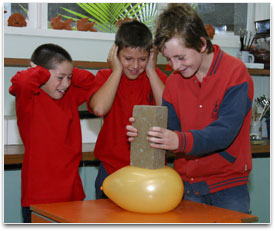This focus idea is explored through:
Contrasting student and scientific views
Student everyday experiences
 Because students associate pushes and pulls with moving or active objects they often believe that stationary or passive objects have no
forces acting on them at all.
Because students associate pushes and pulls with moving or active objects they often believe that stationary or passive objects have no
forces acting on them at all.
This idea is also discussed in the focus idea
Pushes and pulls.
For example, students consider that an active object like a human hand can experience and produce forces, whereas a passive book lying at rest on a table is free from all forces. This view may be commonly held in the middle years and may be still be held by some students in the senior secondary years.
Research:
Gunstone & Mitchell (1998),
Gunstone & Watts (1985)
Students do have everyday experiences of objects breaking or bending when big forces are applied to them but they often fail to recognise that forces are present when there is no observable change or distortion as the force acts. For example, a chair collapsing under the weight force of a person or the stretching of a trampoline are seen to involve forces at work whereas an apple resting in a fruit bowl is not.
Research:
Clement (1987)
Scientific view
For both stationary and moving objects with unchanging speed and direction, all the forces acting on the objects are in balance with each other, i.e. they all cancel each other out.
Passive objects exert forces on objects that are exerting forces on them. For example, a heavy bag resting on a bed pushes on the bed because of its downward weight force and the bed pushes back up on the bag with a balancing force as it is squashed under the load.
All objects undergo some squashing (compression) or stretching and change shape when a force is applied to them. In the case of strong materials like concrete or steel table frames this compression is usually very small and not observable unless the applied force is very large.
Critical teaching ideas
- Stationary objects have forces on them.
- All objects undergo some squashing or stretching when a force is applied to them.
- When an object pushes on another object the first object squashes the second object which pushes back.
 Explore the relationships between ideas about forces in the
Concept Development Maps: Laws of Motion.
Explore the relationships between ideas about forces in the
Concept Development Maps: Laws of Motion.
When one object pushes on another, the surface of the second object is squashed. Because it is squashed the second object pushes back on the first. For example, a chair bends as a person sits on it and because it is bent, it pushes back up on the person.
Research:
Loughran, Berry & Mulhall (2006)
Choose examples or situations for discussion that help students to identify the forces acting on passive objects like tables, simple bridges, mattresses and chairs.
Introduce the notion that some forces happen because objects are stretched or squashed. Develop the ideas that:
- when something is squashed or stretched, it changes shape and pushes or pulls on the thing that is squashing or stretching it
- some things can be squashed or stretched more easily
- the more something is squashed or stretched, the harder it pushes or pulls on the thing that is squashing or stretching it.
Research:
Gunstone & Mitchell (1998)
Teaching activities
Open up discussion via a shared experience
Students should observe and discuss situations where things are being stretched or squashed by large and small forces. It would be helpful for them to feel the forces being exerted by the things that have been stretched or squashed so they can verify the existence of the forces involved.
Challenge some existing ideas
For example:
- A heavy object is placed on top of an inflated balloon, or a piece of spongy foam. After students have observed the surface being squashed by the weight force of the object, they replace the object with their finger and feel the balloon/foam pushing back up as they try to make the balloon a similar shape.
- POE (Predict-Observe-Explain): some heavy books are placed in the middle of a metre ruler supported at both ends so the ruler bends. Students place their finger beside the books on the ruler, so when the books are slowly removed they can try to prevent the ruler from rebounding by providing the push needed to maintain the bent ruler. Students can be asked to predict what will happen if they move the supports closer and repeat the sequence of actions just described. They then observe and explain what happens.
- POE (Predict-Observe-Explain): try the same activity as above but this time with fewer books or place a heavy weight/brick on a plastic soft drink bottle with the lid sealed. Observe the squashing. Now ask the students to predict what will happen if the weight is placed on the bottle with the lid removed.
- An object is suspended from a rubber band so that it stretches. Students are asked to feel the pull of the rubber band at the same extension after the weight has been removed.
Challenge some existing ideas
Students are often surprised to hear that bridges are designed to bend when cars travel over them and that tall buildings are designed to sway in high winds or during earth tremors. Invite students to discuss how they would go about measuring whether a tall building or a motorway was moving in a high wind.
An interesting example to explore is the Millau Bridge in France.
A good site to explore the design of bridges is: